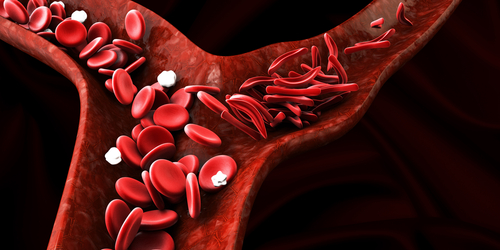Hypertension Medication Valsartan May Help Prevent Vaso-Occlusive Episodes in Sickle Cell Disease, Study Suggests

A medication used to treat high blood pressure, called valsartan, may help decrease the stickiness of red blood cells and reduce the risk of vaso-occlusive crisis in people with sickle cell disease (SCD), a research study suggests.
The study, “Valsartan impedes epinephrine-induced ICAM-4 activation on normal, sickle cell trait and sickle cell disease red blood cells,” was published in the journal PLOS One.
SCD is characterized by the production of abnormal hemoglobin proteins, resulting in red blood cells (RBCs) that are stickier and more prone to aggregate together and to blood vessel walls. When such RBC clumps are formed, they can cause painful blockage of blood vessels, a condition that is called vaso-occlusive crisis (VOC).
This blockage process is in part due to abnormally high activation of cell surface proteins, including the intercellular adhesion molecule-4 (or ICAM-4) that mediates RBC clumps binding to blood vessel walls.
Previous studies have suggested that the hormone epinephrine (commonly known as adrenaline) can also contribute to the increased production of ICAM-4 molecules at the surface of RBCs in response to physical stress.
This research led scientists from the University of Connecticut to explore whether using an inhibitor to block the signals of epinephrine could be beneficial in preventing vaso-occlusive episodes. They evaluated the impact of valsartan, an approved oral therapy to reduce blood pressure and treat congestive heart failure, which is sold with the brand name Diovan by Novartis.
The study enrolled five healthy volunteers, three patients with sickle cell trait (SCT, who have both normal and mutated hemoglobin variants), and six patients with diagnosed SCD, who provided blood samples for analysis.
The team used a technique called atomic force microscopy to collect information on the stickiness status of blood cells. This approach can specifically determine the binding force between ICAM-4 at the surface of RBCs to the blood vessel walls.
The researchers found that the binding frequency of ICAM-4 to vessel walls increased in the presence of epinephrine in all three groups. “We observed that epinephrine significantly increased the surface percentage of active ICAM-4 receptors,” they wrote.
Treatment with valsartan significantly decreased ICAM-4-binding to 10.41% from 17% in RBC samples of healthy volunteers. Similar results were seen in both SCT and SCD samples, with valsartan lowering epinephrine-induced levels of ICAM-4 to 6.87% from 17.11% in SCT blood samples, and to 10.07% from 20.58% in SCD samples.
Supported by these findings, the researchers said that “administration of valsartan could mitigate the vaso-occlusive consequences of SCD and may open new avenues for the development of novel therapeutic targets.”






